 |
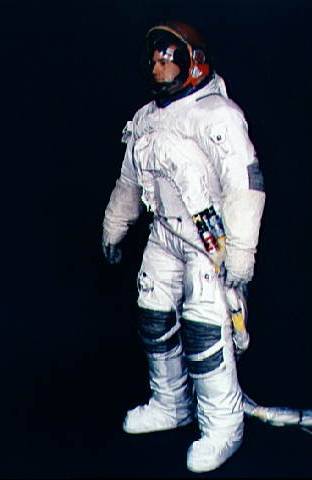 |
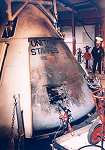 |
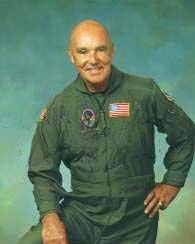 |
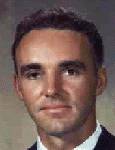 |
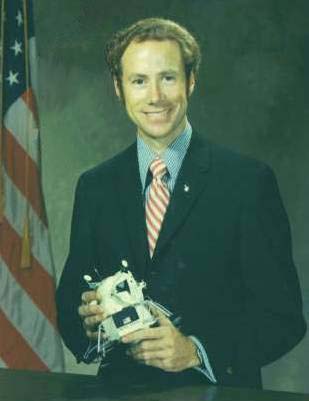 |
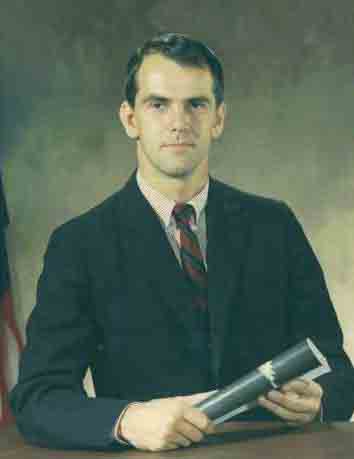 |
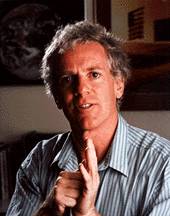 |
| The Silver Pin Astronauts |
| Elliot See was chosen in the second group of astronauts in September 1962 , this is the group that included Neil Armstrong, the first man on the moon, James Lovell, Apollo 13 commander and John Young, six times space veteran so he was in excellent company. His first assignment was backup pilot on Gemini V, this put him in line to fly on the Gemini VIII mission. After a few crew re-shuffles See was moved up to the commanders position on Gemini IX with Charlie Bassett as his pilot. He also served as the capcom during the Gemini 7/6 rendezvous mission. See was going to be the back-up commander for Gemini XII after his assignment on Gemini IX and may have made an Apollo flight but both See and Bassett were never to fly into space. |
 |
| NASA astronauts were given a silver pin upon selection and a gold pin after their first spaceflight, below are the astronauts that were selected before and during the Apollo program but never flew in space. Some of their names have disappeared from the history of spaceflight whilst others remain as a testimony to the sacrifices they made for the advancement of space exploration. |
| See sitting next to a model of the new Gemini spacecraft just after selection in the second group of astronauts. |
| See training as Gemini V backup pilot. |
| Charlie Bassett was selected by NASA in the third group of astronauts in October 1963. He was assigned to the pilots position on Gemini IX and, according to Deke Slayton, he was also the back-up senior pilot for the Apollo 2 mission although this assignment was never officially announced. Gemini IX was to be a complex mission of rendezvous docking and EVA. At the time of his death he was due to be America's third spacewalker and could have been one of the men to walk on the moon aboard one of the later moon flights. |
| On the 28th February 1966 two T-38 NASA jets left Ellington AFB, Texas for a visit to the McDonnell Douglas factory in St.Louis. See and Bassett, the prime crew for Gemini IX, were in the lead with Stafford and Cernan, the back-up crew, acting as their wing men. Approximately one and a half hours after taking off, the two aircraft were approaching the Lambert Field airport next to the McDonnell factory, the weather was overcast with reduced visibilty, and rain, fog and light snow added to the poor conditions over the runway. Stafford and Cernan elected to fly around and make a second approach on instruments when they discovered they had strayed too far down the runway for a safe landing. See decided to maintain visual contact with the runway and circled to his left under the cloud cover and headed in the direction of the factory, he radioed the tower "Final ILS 24." The T-38 jet continued in its turn until See noticed his sink rate was unsafe and hit the afterburners putting the aircraft into a tight right turn at the same time. The plane failed to clear the roof of the factory and its right wing hit the three-storey building where their spacecraft was being assembled, it then crashed into the ground where See's body was thrown from the wreckage and Bassett was decapitated in the rear seat. A crash review announced that there was no fault with the plane and that the poor weather and the pilot's decision to maintain sight of the runway at low altitude were the main contributors to the accident. See appears to have made the wrong decision which is curious for such an experienced pilot who had spent over six years testing the newest jets as a General Electric test pilot and clocking up over 3000 flying hours in jets. |
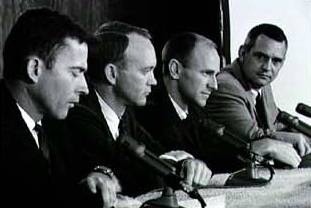 |
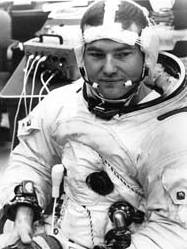 |
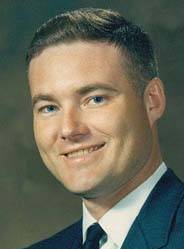 |
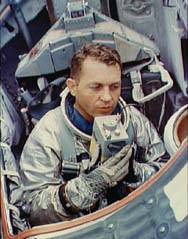 |
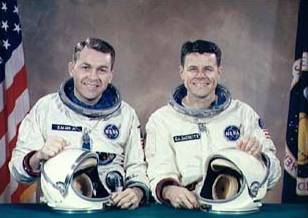 |
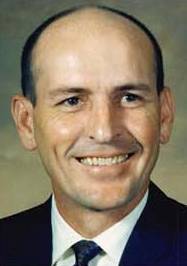 |
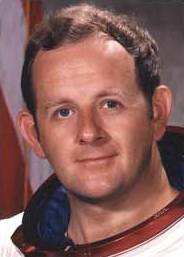 |
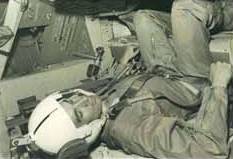 |
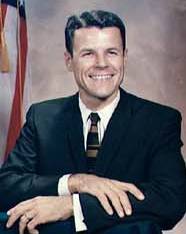 |
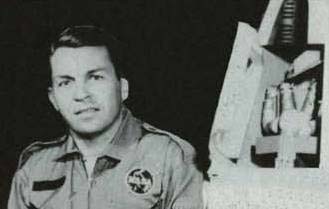 |
| Elliot McKay See Jr |
| Maj Charles Arthur Bassett II USAF |
| The original Gemini IX prime crew |
| On March 3rd 1966 both men were buried in Arlington National Cemetery, the previous day their spacecraft had passed a flag flying at half mast as it left the McDonnell factory on its way to the KSC. Stafford and Cernan, who had no knowledge of the crash until after they had landed, were made the new prime crew for the Gemini IX mission, the first time ever that a back-up crew replaced the prime crew. |
| Chosen as a Group 3 astronaut in October 1963, Ted Freeman became the first US astronaut to die when his T-38 crashed just over a year later in October 1964. Before joining NASA he had worked on some of the last flight tests of the T-38 aircraft at Edwards AFB so he was well versed in the aircraft he was flying the day he died. |
| Capt Theodore Cordy "Ted" Freeman USAF |
| Edward Givens was working at the manned spacecraft centre on the astronaut manoeuvring unit (AMU) when selected for the fifth group of astronauts in April 1966. As the project officer for the AMU, Givens worked with Stafford and Cernan as they prepared for the Gemini IX mission in May 1966. After Gemini he specialized in the command module and was selected as one of the support crew for the Apollo 1 mission, this assignment was announced on December 22nd 1966. He was at the Cape, in his capacity as support crew member, when the fire claimed the prime crew of Apollo 1 just over a month after his assignment to their mission. In March of that year Slayton moved the backup crew for Apollo 1 to the the new prime crew for Apollo 7, he also moved the old Apollo 1 support crew to the new Apollo 7 support crew, all this was officially announced on May 9th 1967. |
| Maj Edward Galen Givens Jr USAF |
| Duane Edgar Graveline |
| Duane Graveline was amongst the scientists chosen in the Group 4 astronaut selection in June 1965. Up until the spring of 1965 he had served as an Airforce surgeon on active duty including conducting space related medical tests. He was a physician working at the MSC as a flight surgeon for the Life Sciences Division when chosen as an astronaut. His personal life was soon to complicate matters and Slayton states that he didn't even make the group photo before being moved back to the Life Science Division. His wife was suing him for divorce and this was incompatible with the image of an astronaut at that time, not to mention the psychological problems this could cause which could have impaired his efficiency during training. He resigned from NASA later that year and became a family physician in Vermont. In the early seventies the situation had changed dramatically and astronauts were allowed to get divorced and still fly to the moon. |
| Graveline now |
| and then |
| Lt-Cdr Roger Bruce Chaffee USN |
| Death sometimes brings it own kind of immortality as space history remembers the crew of Apollo 1. Roger Chaffee was amongst the third astronaut group chosen in October 1963. He was a lieutenant in the USN when selected and became good friends with fellow Group 3 astronaut and USN lieutenant Eugene Cernan. On December 22nd 1966 Chaffee was announced as the pilot on the Apollo 1 crew to conduct a Earth orbital test flight of the block I spacecraft. During a test on the launch pad a fire broke out in the spacecraft and as fire ravaged the interior Chaffee remained in his seat transmitting over the communications line until he was killed along with his two colleagues. At Elliot See's funeral Chaffee had been one of the pallbearers, now less than a year later he was also being buried at Arlington National Cemetery with full military honours. |
| Apollo 1 spacecraft |
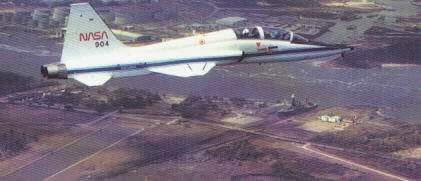 |
| CC Williams was chosen as an astronaut in the third astronaut group along with Bassett, Chaffee and Freeman, all four men would be dead before a single manned Apollo mission had been launched. Coming from a test pilot background, Williams saw space as the next goal to reach for and his determination showed when he spent the night before his medical examination jumping on the spot to compress his spine and thus make the height restriction for becoming an astronaut. He was originally scheduled to be the back-up pilot on Gemini XII with Elliot See but the crew shuffle after the death of See and Bassett resulted in him being paired, as pilot, with Alan Bean on the back-up crew for Gemini X. The official announcement of this crew was made on the 21st March 1966. During March of that year Williams helped out in the selection of the fifth group of astronauts alongside the likes of Alan Shepard, John Young, Max Faget and Warren North. On December 22nd 1966 he was announced as the back-up lunar module pilot (LMP) on Borman's Apollo 3 crew which placed him in line for a possible lunar module test in lunar orbit aboard Apollo 6. After the Apollo 1 fire he shifted to backing up the LMP on McDivitt's crew and closer to his dream of walking on the moon. |
| Maj Clifton Curtis Williams Jr USMC |
| On October 5th 1967 an already dreadful year for astronaut deaths was made even worse when Williams was killed in tragic circumstances. Flying from KSC to the MSC he had planned to stop at Brookley AFB and visit his parents in Mobile, Alabama because his father was dying of cancer. The T-38 plane he was flying went into a rolling dive near to Tallahassee when his controls jammed. Giving a mayday call "Mayday, Mayday, NASA 922 ejecting near Tallahassee," he described his situation and had time to eject but he died when he left it too late and his parachute failed to open. The accident was probably caused by a kit bag in the cockpit jamming the controls although Slayton states that the real cause was never really known. If he had lived he would have become one of the more well known astronauts because he was due to be the fourth man on the moon as LMP alongside Pete Conrad on the Apollo 12 mission. |
| CC Williams, on the right, during his time as backup pilot on Gemini X, this picture demonstrates the different fortunes of the NASA astronauts. John Young flew a total of six missions including two trips into lunar orbit and one to the moon's surface as well as two Gemini flights and two shuttle flights. Michael Collins became the third American to walk in space aboard Gemini X and he also went to the moon as CMP aboard Apollo 11. Williams had been first choice for the Apollo 12 LMP but after his death Alan Bean took his place which is why there are 4 stars on the Apollo 12 mission patch, three for the crew and one for their dead colleague. |
| The T-38 jet |
| When asked during an interview if Apollo crews in spacecrafts were "..as safe as in an airplane" he replied "Really more so." |
| John Sumter Bull |
| A group 5 astronaut, Bull was announced as a support crew member for the Apollo 3 mission on December 22nd 1966. After the Apollo 1 fire he moved to the support crew of McDivitt's Apollo 8 crew on 20th November 1967. Specializing in the lunar module he was selected as a crew member for the LTA-8 tests and also participated in the testing of the new A7L Apollo spacesuit. During initial testing in the vacuum chamber Bull developed a sinus problem which was agravated by the continual changes in pressure he encountered in the chamber. Bull was removed from the LTA-8 crew and later removed from flight status altogether due to a pulmonary disease, he moved to the NASA Ames Research Centre in California. |
| John Young, Michael Collins, Alan Bean and CC Williams. |
| Bull seen on the left testing the new Apollo spacesuit re-designed after the Apollo 1 fire. To The right he is seen during the LM tests, the patch shows the LTA-8 crew and the vacuum chamber the tests were conducted in. If medical problems had not forced his removal from the flight rotation, he would have been certain of a spaceflight as a lunar module pilot. |
 |
| John Anthony Llewellyn |
| Llewellyn seen during training for Apollo |
| Tony Llewellyn was born in Cardiff, Wales, and gained a PhD in chemistry. He was successful in becoming a US astronaut in the sixth astronaut group in August 1967. He dropped out of NASA during flying lessons on jet aircraft in December 1968 and became a professor of chemical engineering at the University of South Florida. |
| Frank Curtis Michel |
| With a PhD in physics Michel was chosen as a scientist-astronaut in 1965. He became upset and outspoken about how little science he was actually doing. He started spending most of his time at Rice University in Texas and later became a professor of astrophysics there when he decided to leave NASA in 1969. |
| Donald Lee Holmquest |
| Donald Holmquest was a MD with a PhD in physiology and he joined NASA in the sixth astronaut group. Whilst some of the other astronaut-scientists were working on Apollo he moved to the Apollo Applications Program but was on leave of absence from May 1971 to his resignation from NASA in September 1973. He went onto be the head of the nulear medicine department at the Navasota Medical Centre. |
| In the mid sixties NASA had grand designs for lunar tugs, 12 man Earth orbiting space stations, moon bases and manned missions to Mars. To cope with the need for men they employed new groups of astronauts and special groups of scientist astronauts, unfortunately the budget cuts of the late sixties forced many of these plans to be abandoned and even Apollo died an early death at number 17. Reflecting this, the amount of missions available were reduced considerably and all the new astronauts were left with no where to go within NASA. One by one they left, but some did remain from the early groups to hang on for a shuttle flight in the eighties. |
| Philip Kenyon Chapman |
| Born in Melbourne, Australia, Chapman joined NASA in the same group as Llewellyn, Holmquest and O'Leary. With a ScD in aeronautics and astronautics he worked on the support crew for Apollo 14 helping in the scientific preparation for the mission. After supporting the Apollo 16 mission he decided to resign from NASA in July 1972. |
| Brian Todd O'Leary |
| Back to Index |
| Chosen in August 1967, O'Leary served as the only planetary scientist in the astronaut corps with a PhD in astronomy. Soon after his selection NASA scrapped their plans to send a manned mission to Mars but not before he: "...got to experience the feeling of anticipating what it would be like to go to Mars." He left NASA because of his fears connected with flying and went onto write an interesting book recounting his time at NASA entitled, "The Making Of An Ex-Astronaut". |
| He left NASA in April 1968 and went onto be become a freelance writer and lecturer. |
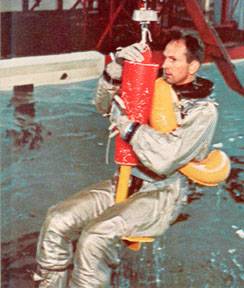 |
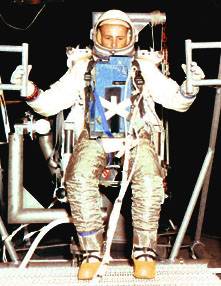 |
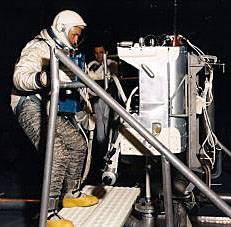 |
| Freeman would probably have been selected as the Gemini IX back-up pilot and gone on to fly aboard Gemini XII. Of course, Freeman and the Gemini IX crew were all killed resulting in significant crew re-shuffles which would prove to have a huge influence on who would be amongst the first and last men on the moon. |
| Givens made an important contribution to the early experiments of the AMU and yet after his death NASA didn't think he was eligible for inclusion on the astronaut memorial at the Kennedy Space Centre. |
| In an interview years later, Graveline admitted that he had thought he was one of the best astronauts chosen in his group, second only to Curt Michel who he found to be a fine astronaut-scientist. |
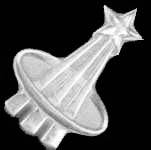 |
| On October 30th 1964, Freeman was approaching the runway at Ellington AFB after making a routine flight in a T-38 jet over the Gulf of Mexico. The tower saw that some other traffic was in the area and told him to fly around and try again. As he was turning his cockpit canopy was hit and shattered by a snow goose. As a result of this impact pieces of canopy were sucked into both engines which promptly shut down after a few seconds, just long enough for him to turn onto a northwesterly heading and level out. Witnessess state seeing an explosion as the airplane descended lower, this was Freeman's ejection seat. Unfortunately the plane was pointing downwards so he ejected horizontally and too low for his parachute to work, he was later found still strapped to his seat having died of a fractured skull and massive internal injuries. Charlie Bassett wrote about Freeman's death thus: "We all feel the loss of Ted Freeman very deeply. He was truly a fine man and a fine pilot." |
| Freeman during training |
| On June 6th 1967 Givens was returning to Houston with two friends from the Air Force when his Volkswagen car left the road, possibly after taking a corner too fast. He was pronounced dead on arrival at hospital and his two passengers were injured. His position on the support crew went to William Pogue and the chance to be one of the first from his group of astronauts to fly in space went to someone else. |
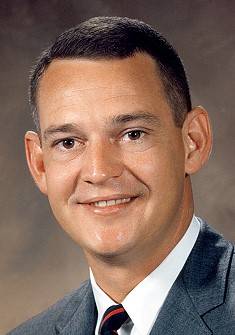 |
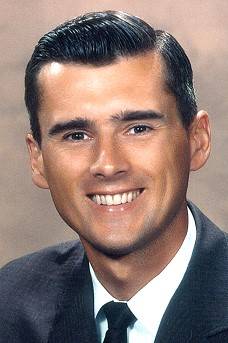 |
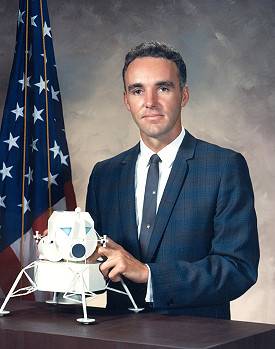 |
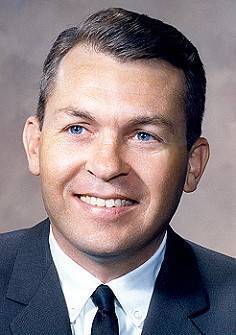 |
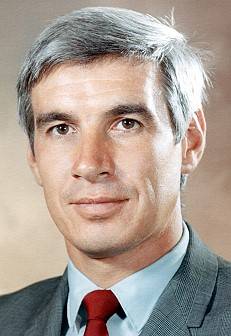 |
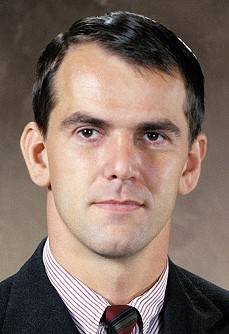 |
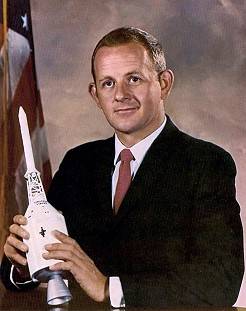 |
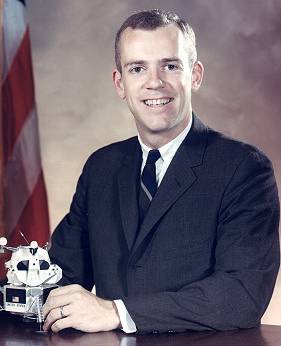 |
| Copyright 2001-2009 by Robert M. Southall |